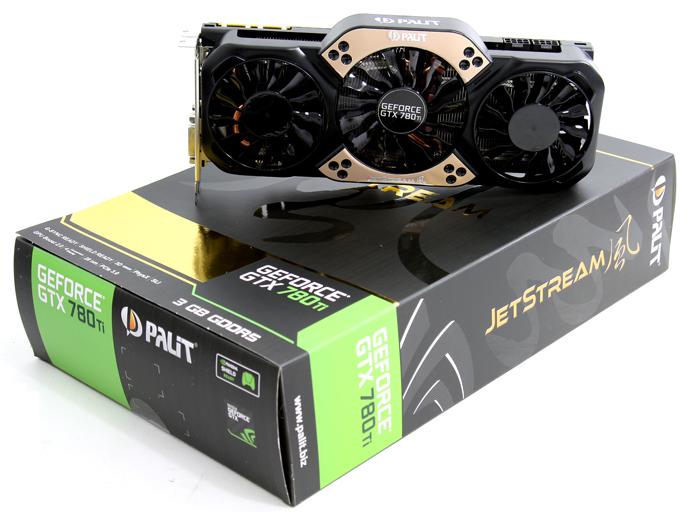Conclusion
Conclusion
Palit once again offers a very competitive product with the JetStream edition of their GeForce GTX 780 Ti. You will receive a product that is running much cooler than the reference products, it's fairly silent and does tweak to a boost clock over 1200 MHz fairly easily without any voltage tweaking. That's pretty impressive for a 7 Billion transistor encounting product with 2880 shader processors alright.
Te Jetstream cooler has far better cooling overall compared to reference as the temperature under gaming or computing stress for this graphics card remains at roughly 65 Degrees C, and that's very noteworthy. Based on FLIR results the temps can be up-to 5 degrees higher though. Still, that is really nice and the end result is a graphics card that is a notch faster then the GeForce GTX Titan for far less money. Speaking about money, the suggested retail price of the GeForce GTX 780 Ti is set at 699 USD. In the EU based on VAT differences that would boil down to roughly 650 EUR. And sure, a lot of money, but considering the Titan still sells in the 800~900 EUR range this product actually makes sense. The biggest differences in-between the Titan and the GTX 780 Ti are twofold, obviously 3GB graphics memory will save some cost for NVIDIA. That said, with Ultra HD gaming becoming a big thing we do feel that cards of this caliber should have gotten 4 GB of memory at the last. Even with BF4 in UHD / Ultra 4xMSAA we already are filling that framebuffer close to 3GB. Future games will get UHD texture packs and I foresee that 3GB utilization will be breached. The second difference in-between Titan and GTX 780 Ti is Double Precision. Titan will remain the product to get if youy are computing a lot, you get full DP on it whilst the GTX 780 and 780 Ti will run DP in a 1:24 ratio. But that's not a troublesome factor for gaming whatsoever though. But sure, it really is one of the finer GeForce GTX 780 Ti cards available on the market. We had a great time testing this graphics card.
Aesthetics
Powered with that JetStream cooler the card runs a good 10 to 15 Degrees Celsius colder opposed to the reference cooler whist remaining fairly silent. This revision is a triple-slot cooler though, with two 80mm and one 90mm fan. I think overall it just looks great. The 8-phase VRM design PCB is customized and I can spot merely quality components ensuring a longer lifespan of this product, lovely. The looks, well the cooler in its all black design, the subtle and silent fans combined with a hint of beige/gold makes this a good looking package alright. Great looking and very sturdy I must state as well. There is a metal plate at the top of the card so the card cannot bend when seated horizontally in the PC, missing however is a full cover back-plate. The one downside, it eats away three PCI slots, personally i don't care as I have the room for it. But I'm sure there will be a handful of you disliking it. It remains a trade-off though, as in return you get to enjoy sheer silence and cool temps.
Cooling & Noise Levels
The NVIDIA reference coolers do their job well, but they follow the temperature target of 80 Degrees C. With the JetStream cooling technology the GPU will get roughly 400 to 450W of cooling power thrown at it. As a result the temperature target might remain at 80 Degrees C, but we have never seen the card pass 65 Degrees and 70 C on thermal imaging (measured at the backside of the PCB at the GPU location). With the temperature is that low there is an extra benefit... the power and temp limiters do not kick in, allowing the product to boost a little higher than usual. In its default configuration you barely hear airflow when the GPU is under stress installed in a PC. Even whilst overclocked at the level we'll discuss over the next paragraphs, it remains silent.
Power Consumption
Once again not bad, the card is still rated at as having a 250 Watt TDP, we measure that to be a little higher though, roughly 260 to 265 Watts (under full stress). But at this performance level, that is absolutely okay. That 250 Watt TDP also will make running multi-GPU solutions a bit more easy. With two card we think an 800 Watt PSU would be sufficient. So while it's not great to have a GPU sucking up 250 Watt it could have been a lot worse, really. If you look at the dual-GPU based ARES II for example, that card alone draws 500 Watt / 250 Watt per GPU. So, perspective is the word I like you to keep in mind.
Game Performance
GeForce GTX 780 Ti in most scenarios will be 5 to 10% faster than the GTX Titan, comparing towards GTX 680 it seems 40% faster. Drivers wise we can't complain at all, we did not stumble into any issues. And with a single GPU there's no micro-stuttering (if that ever bothered you) and no multi-GPU driver issues to fight off. Performance wise, really there's not one game that won't run seriously good at the very best image quality settings. Gaming you must do with a nice 30" monitor of course, at 2560x1440/1600. I mean Battlefield 4 at Ultra quality is still oozing out 65+ FPS there. Or what about Hitman Absolution with 65+ FPS at 2560x1440 High quality and 2xMSAA? At these resolutions the GeForce GTX 780 Ti offers just a phenomenal gaming experience with image quality that you can only see on a PC.
Overclocking
The card is already clocked for you at 980 MHz (875 = reference clock)) and boosting to 1046MHz. This GPU can take 1150 MHz fairly easily really, and at that stage you added another 10% performance already. Our tweak made the GPU run at 1100-1150 MHz whilst boosting over 1200 Mhz (depending on temperature, power draw and load). This result is fairly similar on all GTX 780 Ti cards, mind you that we did not voltage tweak. That way this 2880 Shader processor card at a boost frequency of 1200+ MHz this way only consumes 10~15 Watts more, nice huh. With additional voltage tweaking we have no doubt you'll pass the 1300 MHz marker, but the power limiters on recent NVIDIA graphics cards are restrictive and a tricky thing and your power consumption will jump upwards real fast.
Concluding
Palit's JetStream version of the GeForce GTX 780 Ti is an adorable product if you ask me, 3-slot size aside, from A to Z it is such a gorgeous product to own. It is sturdily build with good components quality, it's darn fast in performance as it even can pass the mighty GeForce GTX Titan. The GeForce GTX 780 Ti is a powerhouse of technology. Silky smooth and fluid framerates is what you'll get thanks to the tremendous horsepower at hand. It does so while hardly making any noise and with dynamically adjustable temperatures you can decide yourself how hot your GPU may run. The card is a severe chunk faster compared to the GeForce GTX 680 and the Radeon HD 7970 GHz edition. Direct competition is of course the R9 290X from AMD, up-to 2560x1440 the GTX 780 Ti, mostly wins. At Ultra HD levels the cards get closer to each other though. The MSRP pricing for the GeForce GTX 780 Ti is EUR 579.00 excl. VAT (US $699 incl. VAT), meaning roughly 650 EUR incl VAT in the EU. One sidenote in general, I would applaud the first board partner to release a 6GB model of the GeForce GTX 780 Ti. That's a gap in the market to fill as we speak. In conclusion there's very little left to be said really. Palit's JetStream version of the GeForce GTX 780 Ti pretty much rocked. The factory tweak could have been a small notch higher, but now I am truly nitpicking. Gaming wise it's extremely fast, relatively very silent and hey, it's a looker as well. We reward the Palit GeForce GTX 780 Ti JetStream edition with our top pick award. It is well deserved as the card is amongst the best of the best.
If you are interested, we have a GeForce GTX 780 Ti SLI article as well, read that over here.
Recommended Downloads
- Sign up to receive a notice when we publish a new article
- Or go back to Guru3D's front page



